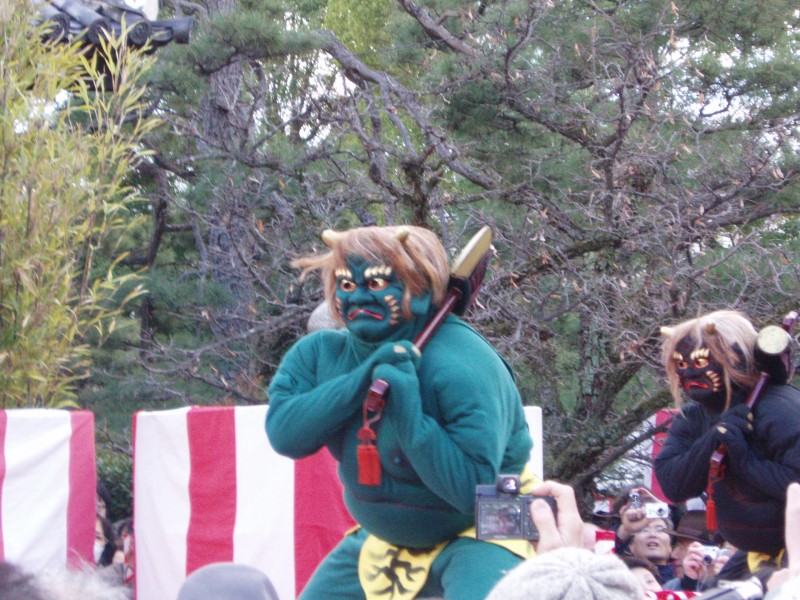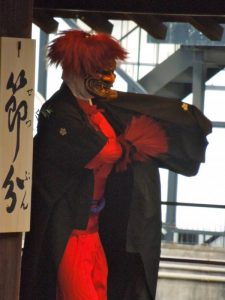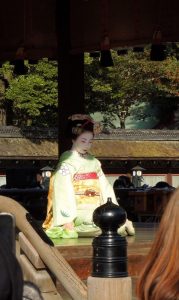 For the next two days, Japan will be celebrating the fun festival of Setsubun. Green Shinto has reported on the events in Kyoto on a number of previous occasions: see here, or here, or here. The event centres around throwing beans at demons. But why? (click here to find out) To learn about the historical background, click here.
For the next two days, Japan will be celebrating the fun festival of Setsubun. Green Shinto has reported on the events in Kyoto on a number of previous occasions: see here, or here, or here. The event centres around throwing beans at demons. But why? (click here to find out) To learn about the historical background, click here.
One of the great virtues of Hearn’s writing on Japan is that it records rites and rituals which have been altered, curtailed or terminated altogether since his time. In the Second Series of Glimpses of Unfamiliar Japan, he describes how Setsubun was practised in the city of Matsue while he resided there in 1891. As always, Hearn’s sympathetic understanding of the event underscores the narrative, as well as his attention to detail.
The other festival I wish to refer to is that of the Setsubun, which, according to the ancient Japanese calendar, corresponded with the beginning of the natural year – the period when winter first softens into spring. It is what we might term, according to Professor Chamberlain, ‘a sort of movable feast’; and it is chiefly famous for the curious ceremony of the casting out of devils – Oni-yarai.
On the eve of the Setsubun, a little after dark, the Yaku-otoshi, or caster-out of devils, wanders through the streets from house to house, rattling his shakujo (priest’s staff), and uttering his strange professional cry: ‘Oni wa soto!-fuku wa uchi!’ [Devils out! Good-fortune in!] For a trifling fee he performs his little exorcism in any house to which he is called. This simply consists in the recitation of certain parts of a Buddhist kyo, or sutra, and the rattling of the shakujo. Afterwards dried peas (shiro-mame) are thrown about the house in four directions. For some mysterious reason, devils do not like dried peas – and flee therefrom. The peas thus scattered are afterward swept up and carefully preserved until the first clap of spring thunder is heard, when it is the custom to cook and eat some of them. But just why, I cannot find out; neither can I discover the origin of the dislike of devils for dried peas. On the subject of this dislike, however, I confess my sympathy with devils.
At Yasaka Jinja the local Gion geisha get to throw the beans
After the devils have been properly cast out, a small charm is placed above all the entrances of the dwelling to keep them from coming back again. This consists of a little stick about the length and thickness of a skewer, a single holly-leaf, and the head of a dried iwashi – a fish resembling a sardine. The stick is stuck through the middle of the holly-leaf; and the fish’s head is fastened into a split made in one end of the stick; the other end being slipped into some joint of the timber-work immediately above a door. But why the devils are afraid of the holly-leaf and the fish’s head, nobody seems to know. Among the people the origin of all these curious customs appears to be quite forgotten; and the families of the upper classes who still maintain such customs believe in the superstitions relating to the festival just as little as Englishmen to-day believe in the magical virtues of mistletoe or ivy.
One more feature of the Setsubun festival is worthy of mention – the sale of the hitogata (‘people-shapes’). These are little figures, made of white paper, representing men, women, and children. They are cut out with a few clever scissors strokes; and the difference of sex is indicated by variations in the shape of the sleeves and the little paper obi. They are sold in the Shinto temples. The purchaser buys one for every member of the family – the priest writing upon each the age and sex of the person for whom it is intended. These hitogata are then taken home and distributed; and each person slightly rubs his body or her body with the paper, and says a little Shinto prayer. Next day the hitogata are returned to the kannushi[priest], who, after having recited certain formulae over them, burns them with holy fire. By this ceremony it is hoped that all physical misfortunes will be averted from the family during a year.




Leave a Reply